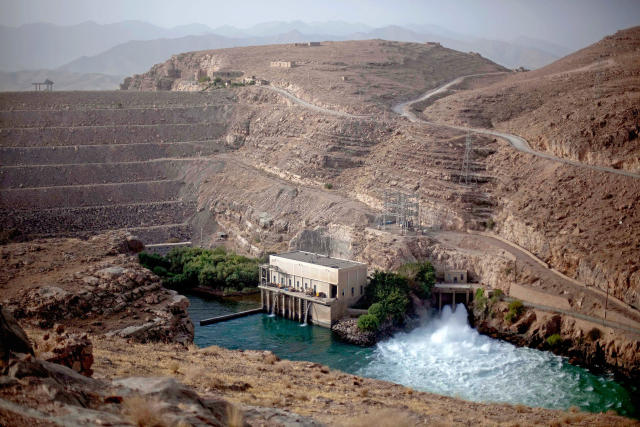
With Iran-Afghanistan on the brink of a ‘water war’, who else might be drawn in?
The Taliban has traded bullets with Iranian guards over water supplies and issues are also brewing with Turkmenistan, Tajikistan, Uzbekistan.
Recent canal and dam work could lead to a tipping point, with the EU, China and Russia not expected to be passive bystanders.
The perception of insecurity overflowing from Afghanistan into neighbouring countries has mainly centred on terrorist threats or drug smuggling.
But a possible “water war” is another variable that is inserting itself with vehemence into the region’s threat matrix, with climate change and the ongoing food crisis already exacerbating water insecurity.
In May, along the nation’s border with Iran, the Taliban shifted from trading barbs to exchanging bullets with Iranian border guards, with fatal results.
One reason for the escalating tension may be traced to the militant group’s upgrades of the Kamal Khan and Kajaki dams on Afghanistan’s Helmand River, the nation’s longest, stretching 1,150km (710 miles). According to Iranian officials, the Taliban are now violating a six-decade old treaty over the amount of water flowing into Iran’s arid eastern areas by limiting what was previously agreed.
According to Iranian officials, the Taliban are now violating a six-decade old treaty over the amount of water flowing into Iran’s arid eastern areas by limiting what was previously agreed.
Following last month’s gunfight, Iranian President Ebrahim Raisi warned the Taliban not to violate his people’s water rights and said Iran was determined to defend those rights.
At the same time, another water war looms on the horizon, this one involving the Qosh Tepa Canal being built by the Taliban to harness the Amu Darya River. It provides water to Afghanistan as well as to the neighbouring nations of Turkmenistan, Tajikistan, and Uzbekistan to the north. The reaction from those three Central Asian countries has been less belligerent than the Iranian one, but they all concur on the Taliban’s stubbornness to find common ground.
The reaction from those three Central Asian countries has been less belligerent than the Iranian one, but they all concur on the Taliban’s stubbornness to find common ground.
For example, improvements to the 1950s-built Kajak Dam were put on ice for years because of the nation’s fight against the Soviet Union and later against the United States.
While on May 27 the friction over the 900km Afghan/Iranian border escalated into a skirmish that left several bodies on the ground, rising tensions over water supplies along the northeastern border do not look much better.
According to recent satellite images, the planned 285km excavation for the Qosh Tepa Canal extends 136km, with 53km filled with water. Around 7,000 workers are involved. Uzbek commentators have said the way the canal is being built is medieval and will lead to erosion and groundwater seepage.
Water shortages have been a severe issue for many years in the region but the recent work by the Taliban could easily push the situation to a tipping point.
There could be a rapid escalation, as the EU, China and Russia are not passive bystanders.
The EU’s commitment to climate, peace, and security has been on the rise in Central Asia, especially in Tajikistan. Nevertheless, since the invasion of Ukraine in February 2022, Russia has continued to tighten its relationship with Central Asian countries.
It is not by chance that during his June 6 visit to Tajikistan’s capital city, Dushanbe, Russia’s Foreign Minister Sergey Lavrov said “development assistance” programmes promoted by Western “geopolitical engineers” are, in fact, control tools designed to reformat the region’s political and economic landscape as they see fit, including in the key area of water use.
From a Chinese standpoint, the Shanghai Cooperation Organisation, made up of China, Russia, Kazakhstan, Kyrgyzstan, Tajikistan, and Uzbekistan, is also active in dealing with water crises. Regional water rights and usage are among the pillars of the organisation.
But while everyone is conscious that a water crisis stemming from Afghanistan could lead to armed conflict, the key question on how to engage the Taliban remains unanswered.
Another problem adding to the difficulties is that the Qosh Tepa Canal is in the north of the country, an area not fully under Kabul’s grip. The recent killing of the governor of the northern Balkh province by the Islamic State Khorasan – the regional affiliate of the Islamic State group – is a case in point.
As climate change accelerates and its effects are increasingly felt, cycles of drought and reduced rainfall are inflicting a heavy toll on agricultural production and water utilisation efficiency.
Respect for water distribution agreements is a key factor that first and foremost needs cooperation. This is something that is not going to happen any time soon considering that, as the World Food Programme says, Afghanistan is experiencing its highest risk of famine in a quarter of a century.
More than 20 million people are acutely food insecure and 6.1 million people are on the brink of famine-like conditions in the country.
In the short term, control over the Helmand and Amu Darya rivers offers the Taliban the opportunity to kill two birds with one stone: a quick fix in agricultural production improvement, and increased internal political legitimacy. Plus, control over scarce water resources gives the Taliban another string to their bow, allowing them to get further financial and energy concessions from their neighbours.
Overcoming Afghanistan’s ongoing political isolation to solve the looming water crisis is a herculean task. Climate change is accelerating the clock which is ticking towards the point of non-return.
But finding the right incentives to foster region-wide sustainable economic development and climate smart agriculture cooperation is in everyone’s interest, not least the Taliban’s.
Dr Alessandro Arduino is an affiliate lecturer at Lau China Institute King’s College London, specialising in the convergence of technology innovation and national security.







No comments:
Post a Comment
Note: Only a member of this blog may post a comment.